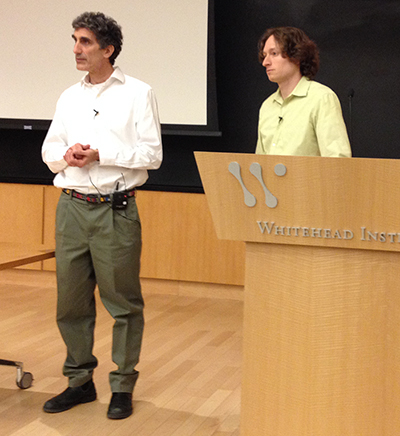At last week’s xTalk/HHMI presentation, Jeremy Orloff and Jonathan Bloom shared their experience teaching a Probability & Statistics class for non-math majors (18.05). Their goal was to bring student-centered active-learning into what had been a traditional lecture course with dwindling enrollment and slated for possible cancellation.
Their first year teaching the course in 2012, Orloff and Bloom taught in lecture/recitation format, but they were interested in exploring new approaches such as active learning and online resources. As they made changes in the format and design of the class, enrollments grew: starting with 30 students in 2012, 40 in 2013, and 60 in 2014. Their innovations impacted curriculum, pedagogy, classroom space, and use of technology.
 The organization of the course comprises three 80-minute sessions each week with a staff of two teachers and three assistants, and meets in the Stata TEAL Room (Technology Enabled Active Learning). The course is flipped: before each class students are assigned a targeted reading written by Orloff and Bloom with questions on MITx that must be answered for credit (5% of grade).
The organization of the course comprises three 80-minute sessions each week with a staff of two teachers and three assistants, and meets in the Stata TEAL Room (Technology Enabled Active Learning). The course is flipped: before each class students are assigned a targeted reading written by Orloff and Bloom with questions on MITx that must be answered for credit (5% of grade).
The in-class time uses minimal lecture with no examples. Instead, students work examples in small groups at the white boards while teachers and assistants circulate, correcting misconceptions and guiding. Orloff and Bloom observe that students learn more working one example than observing a teacher work multiple examples.
Clicker-response questions are also used to gauge student understanding. Clickers offer the added function of taking attendance (and comprise 5% of the grade).
The Friday meeting of the class is a computer-based studio and the only time students are allowed to have their computers out. Students explore concepts through experimentation and simulation using the open source software R and RStudio.
The course assigns traditional problem sets once a week, but uses a p-set checker that allows students to check homework ahead of time. This enables students to reflect on their process while they are learning, not weeks later when they receive their p-set grade.
 During the presentation, Dr. Bloom demonstrated a learning exercise using Bayesian inference, a new 3-week unit in the syllabus. Choosing randomly (and secretly) one die from a group of different-sided dice of 4, 6, 8, 12, and 20 sides, Bloom shook the die several times. With each result he asked the audience to infer which die it might be. The discussion that ensued illustrated the audience’s crowd-sourced intuitive reasoning.
During the presentation, Dr. Bloom demonstrated a learning exercise using Bayesian inference, a new 3-week unit in the syllabus. Choosing randomly (and secretly) one die from a group of different-sided dice of 4, 6, 8, 12, and 20 sides, Bloom shook the die several times. With each result he asked the audience to infer which die it might be. The discussion that ensued illustrated the audience’s crowd-sourced intuitive reasoning.
Orloff and Bloom shared some lessons learned from their experiences:
Teaching the class the first time through using these modalities and formats is extremely enjoyable, but much more difficult in terms of preparation. This style of teaching is more exposed and one cannot rely on notes or improvisation. Subsequent iterations of the class will be easier, and Orloff and Bloom hope to transition the class to other teachers over the next few years.
They are also interested in the assessment work that Dr. Glenda Stump from TLL is doing to gauge student learning in comparison to the traditional class format. Preliminary results are promising.